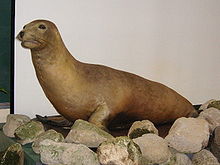Japanese Sea Lion
| Japanese sea lion | |
|---|---|
 |
|
| Taxidermied specimen, Tennōji Zoo, Osaka, Japan | |
| Scientific classification | |
| Kingdom: | Animalia |
| Phylum: | Chordata |
| Class: | Mammalia |
| Order: | Carnivora |
| Suborder: | Caniformia |
| Clade: | Pinnipedia |
| Family: | Otariidae |
| Genus: | Zalophus |
| Species: | †Z. japonicus |
| Binomial name | |
|
Zalophus japonicus (Peters, 1866) |
|
The Japanese sea lion (Japanese: ニホンアシカ Hepburn: Nihon ashika?, Zalophus japonicus) was an aquatic mammal thought to have become extinct in the 1970s.
Prior to 2003, it was considered to be a subspecies of California sea lion as Zalophus californianus japonicus. However, it was subsequently reclassified as a separate species. Some taxonomists still consider it as a subspecies of the California sea lion. It has been argued that Z. japonicus, Z. californianus, and Z. wollenbaeki are distinct species because of their distant habitation areas and behavioral differences.
They inhabited the Sea of Japan, especially around the coastal areas of the Japanese Archipelago and the Korean Peninsula. They generally bred on sandy beaches which were open and flat, but sometimes in rocky areas.
Currently, several stuffed specimens can be found in Japan and in the National Museum of Natural History, Leiden, the Netherlands, bought by Philipp Franz von Siebold. The British Museum possesses a pelt and four skull specimens.
Male Japanese sea lions were dark grey and weighed about 450 to 560 kg, reaching lengths of 2.3 to 2.5 m; these were larger than male California sea lions. Females were significantly smaller at 1.64 m long with a lighter colour than the males.
Japanese sea lions were primarily found in the Sea of Japan along the coastal areas of the Korean Peninsula, the mainlands of the Japanese Archipelago (both sides on the Pacific Ocean and Sea of Japan), the Kuril Islands, and southern tip of the Kamchatka Peninsula.
...
Wikipedia

